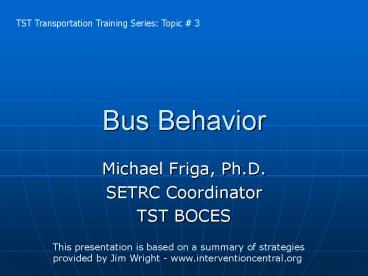Bus Behavior - PowerPoint PPT Presentation
1 / 16
Title:
Bus Behavior
Description:
Write letters of recommendation. Assign Seating for Misbehaving Students ... Next to each student's name on the chart, list that student's teacher or ... – PowerPoint PPT presentation
Number of Views:220
Avg rating:3.0/5.0
Title: Bus Behavior
1
Bus Behavior
TST Transportation Training Series Topic 3
- Michael Friga, Ph.D.
- SETRC Coordinator
- TST BOCES
This presentation is based on a summary of
strategies provided by Jim Wright -
www.interventioncentral.org
2
Appoint Peer Bus Helpers
- Service-industry career skills
- Bus helpers to younger students
- School should provide regular feedback
- Write letters of recommendation
3
Assign Seating for Misbehaving Students
- Let all riders know that sitting where they
choose on the bus is a privilege to be earned - Several days to a 'time-out' seat
- Will remain in this assigned seat until the
student shows appropriate behavior for a
predetermined number of days
4
Assign Seating for the Entire Bus
- At the start of the year, create a seating chart
for the bus - Next to each student's name on the chart, list
that student's teacher or homeroom help the
driver to learn student names more rapidly
- Sets a tone of behavioral control
- Turn student seating into a familiar routine
rather than a daily free-for-all
5
Invite School Authority Figures for Bus Visits
- Periodic surprise visits to the bus
- School principal, classroom teachers, and school
resource police officers are all good choices - Remind students of appropriate bus behaviors
- Praise them if their bus general bus conduct has
been good
6
Link Bus Behavior to a School Reward System
- Can earn or lose school incentives as a result of
their bus conduct - Explain to students how bus behaviors are tied
into this system
7
Match Interventions to Severity of Bus
Misbehavior Tier I
- Tier I misbehaviors could include spitting or
using abusive language and might result in the
students meeting with the classroom teacher or
principal and perhaps being assigned to bus
safety class
8
Medium Level (Tier II)
- Medium-level (Tier II) misbehaviors could include
a rider hanging his or her arm out of the window
or bullying another student and might require a
meeting between the student, parent, and
principal bus safety classand possibly the
temporary suspension of the student from
extracurricular activities.
9
High-Level (Tier III)
- A high-level (Tier III) misbehavior could include
physical fights or defacing the bus with graffiti
and might result in the students assignment to
bus safety class, the temporary suspension of the
student from extracurricular activities, and the
requirement that the student make amends to the
injured party or pay restitution for damaged
property.
10
Promote a Positive Bus Environment
- Drivers who have frequent positive interactions
with students generally experience significantly
better bus behaviors than drivers who primarily
emphasize reprimands and punishments
11
Promote a Positive Environment
- Greet each rider by name as the student enters
the bus, giving a student a non-verbal signal
such as a thumbs-up sign, and praising a
student's bus behavior in front of a waiting
parent as the student disembarks
12
Power of the Positive
- Show an interest in each student
- Dont hold a grudge
- Reinforce good behavior
- Keep your sense of humor
13
Pull Over to Collect 'Time Owed' for Misbehavior
- If group behaviors on the bus become unsafe, the
driver should pull over and wait until those
behaviors are brought back under control - Inform parents and students that bus drivers are
required to pull over whenever the behavior of
riders presents a safety risk - Behaviors on the bus have become unsafe, the
driver delivers one warning - Minimum 'time-out' period.
14
Send Misbehaving Students to Bus Safety Class
- Reteaching of appropriate bus-riding skills
- Teaches acceptable bus behaviors through
demonstration, adult modeling, and student
role-play. - Decide on the threshold of misbehavior that will
trigger a student's referral to bus safety class - After a student completes the class, send his or
her parents a letter
15
Sign a Bus Behavior Contract
- Every student sign a bus behavior contract
- Teach and review positive bus behaviors
- Instilling a sense of responsibility in riders
- No more than 4-6 rules
- Describe the positive behavior that students are
expected to display - Students and parents sign
16
Teach Appropriate Bus Behaviors
- Explicitly taught those behaviors
- Explained and demonstrated
- Train older, responsible students on each bus to
demonstrate

